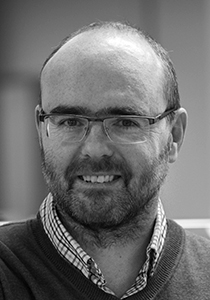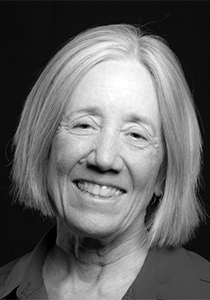Citation for Graham Pearson

Graham Pearson merits the 2019 Norman L. Bowen Award for adding to our fundamental understanding of igneous processes in the upper mantle through studies of volcanic rocks, exhumed mantle sections, subcontinental mantle samples, and diamonds and their inclusions. Pearson has tackled the major topics in mantle geochemical evolution with a research tool kit that ranges from petrography, mineralogy, and petrology through stable isotopes, radiogenic isotopes, siderophile elements, and spectroscopy. In using these techniques, Pearson has sought new analytical method developments that push the frontiers of analytical sensitivity and precision.
Colleagues will remember a long list of discoveries: large pieces of Earth’s mantle emplaced from the diamond stability field; eclogite xenoliths in kimberlite as Archean subducted oceanic crust; continental mantle keel age-match with overlying crust; Re-Os sulfide age-dating of single sulfide inclusions in diamond; kimberlite derivation from unique mantle sources; the Os isotopic imprint in the oceanic mantle of continental crust extraction; trace element abundances in gem diamonds and source fingerprinting; a modern subduction analogue for Archean craton formation; and the finding, in a superdeep diamond, of the first terrestrial ringwoodite.
In this latter accomplishment, we see a typical example of why Graham Pearson is especially deserving of the Bowen Award. He led the effort to successfully measure the water content of a delicately metastable single grain of ringwoodite while it was encased in the diamond so it could avoid breakdown and thereby retain all of its original water. In perhaps one of the most important mineral analyses ever made, Pearson and coworkers were able to show directly that the ringwoodite had approximately 1.5 wt % water. For the first time, here was confirmation that the mantle transition zone can be wet.
In consideration of the sum and variety of his contributions, we deservedly honor Graham Pearson for the wide interdisciplinary influence of his work in understanding the mantle at all depths.
—Steven B. Shirey, Carnegie Institution for Science, Washington, D.C.
Response
Thank you, Steve, for your very generous and flattering words. Thanks also to those who nominated me for this award. I am rather humbled by your faith in me. I have just two things in common with Bowen: my Canadian citizenship and time spent at the Carnegie Institution of Washington. I strongly recommend both.
My career has been blessed with a series of fortunate events and fruitful collaborations with a long list of talented people too numerous to mention but too important to ignore. On entering university, I wanted to be a mining geologist—something I still pretend to be when visiting diamond mines—but inspiring undergraduate teaching by Bob Thompson at Imperial College diverted my path. Having two amazing Ph.D. supervisors in Pete Nixon and Gareth Davies was key in pushing me on my way through life. Pete’s infectious fascination with the mantle and his personal integrity are something to aspire to.
Postdoc mentors of the stature, quality, and generosity of Steve Shirey, Rick Carlson, Joe Boyd, and Chris Hawkesworth gave me no excuse to fail. After 15 happy years at Durham, I was lured to Canada, where I am blessed with truly supportive colleagues who make working at the University of Alberta an absolute pleasure.
But I want to end by focusing on a group of people who often do not get the credit they deserve. Without the dedication, enthusiasm, and support of the lineup of lab managers and technical support I have been fortunate to work with through my career, I would have produced very little. So I’d like to acknowledge Geoff Nowell, Chris Ottley, Sarah Woodland, Yan Lou, and Chiranjeeb Sarkar, who, along with all of my students and postdocs, and my heroic wife, Sam, rightfully own some part of this award.
—Graham Pearson, University of Alberta, Edmonton, Canada
Citation for Mary R. Reid

Mary Reid is receiving the Bowen Award for her creative and innovative application of zircon geochronology for understanding active silicic magma systems. Her 1997 paper in Earth and Planetary Science Letters, “Prolonged residence times for the youngest rhyolites associated with Long Valley caldera: 230Th–238U ion microprobe dating of young zircons,” launched a new area of inquiry into magmatic processes, presenting both the analytical and intellectual framework for conducting and interpreting the geochronology of young zircon by secondary ion mass spectrometry. The unique and groundbreaking insights of this paper shifted our understanding of the rates and processes involved in magma storage, recharge, and eruption.
Mary used U–Th disequilibrium dating to show that zircons contained within the products of a single eruption have ages that span tens to hundreds of kiloyears, implying a complex and protracted preeruption history of subvolcanic magmatic evolution. Were the zircons recording the residence time of melt-rich and potentially eruptible magma (her preferred interpretation at that time), or were zircons being recycled from largely solidified parts of a much broader magma reservoir? These questions in turn spurred efforts by the modeling community to explore the conditions required to maintain melt-rich, silicic magma over these timescales and parallel efforts to understand the processes and timescales of silicic melt segregation from crystal mush. Mary’s work subsequent to the 1997 paper, both on her own and with her students, on Long Valley, Yellowstone, and the Youngest Toba Tuff, represent collectively a tour de force of insights into the operation of large, hazardous silicic magma systems. These papers, along with the many papers by other researchers using her techniques, have revealed subvolcanic magma systems to be dynamic, long-lived, and complex environments. Mary Reid’s work on silicic magma systems has had an enduring impact on the volcanology, geochemistry, and petrology fields. She is deserving of the Bowen Award in every respect.
—Jonathan Miller, San José State University, San Jose, Calif.
Response
A heartfelt thanks to AGU for the Bowen Award, one that carries a name known to every student of geology! I am truly honored and humbled. Thanks in particular to you, Jonathan Miller, for nominating me, and to Olivier Bachmann, Calvin Miller, and Tom Sisson for writing thoughtful—apparently!—letters of support. The four of you, and innumerable other scientific colleagues and friends, have made adventures in the world of geochemistry and petrology lively, provocative, and gratifying.
I have been continually intrigued by the generation and storage of magmas and by developing new approaches for our understanding of them. It has been gratifying therefore to watch myriad new insights unfold as our scientific community unlocked the clocks stored within individual crystals. I am indebted to Jim Gill, who first introduced me to U-series disequilibrium dating, and to Tim Grove, Stan Hart, and Nobu Shimizu, who encouraged me to pursue research independently and inspired me with their diverse approaches to dissecting complex geologic problems. The University of California, Los Angeles gang of Mark Harrison, Kevin McKeegan, and ion microprobe whiz Chris Coath created the intellectual and technical environment that made it possible for me to tease tiny time signals from micron-scaled domains within minerals. Working with and nurturing the careers of many talented graduate students have been the proverbial gifts that keep on giving, especially as they keep me honest about magmatic processes. In the context of this honor, I particularly want to acknowledge Wendy Bohrson, Kari Cooper, and Jorge Vazquez. Finally, my life would not be complete without my family: Jim Sample, Caitlin Sample, Jane Reid, Janne Blichert-Toft, and Francis Albarede. You are my trusted supporters, critics, and companions, always encouraging me to look beyond the horizon.
—Mary R. Reid, Northern Arizona University, Flagstaff
Citation:
(2020), Pearson and Reid receive 2019 Norman L. Bowen Awards, Eos, 101, https://doi.org/10.1029/2020EO149801. Published on 28 September 2020.
Text © 2020. AGU. CC BY-NC-ND 3.0
Except where otherwise noted, images are subject to copyright. Any reuse without express permission from the copyright owner is prohibited.
Text © 2020. AGU. CC BY-NC-ND 3.0
Except where otherwise noted, images are subject to copyright. Any reuse without express permission from the copyright owner is prohibited.
